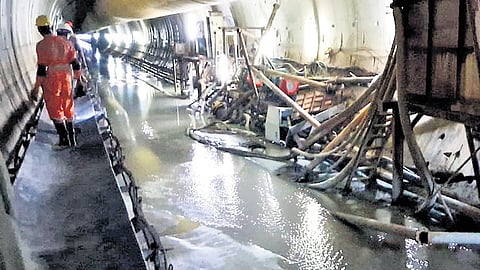

In a heartbreaking turn of events, the Srisailam Left Bank Canal (SLBC) tunnel project, which had resumed operations after years of delay, faced a tragic incident on Saturday. A section of the tunnel’s roof collapsed in the ‘shear zone,’ leaving eight workers trapped and in imminent danger. The situation is not only a human tragedy but also underscores the recurring issues that have plagued the project for decades.
The collapse of the tunnel’s roof, forming debris and spreading mud over 400 to 500 metres, has once again raised questions about the efficacy of modern technology in predicting geological risks. Despite approval from the Geological Survey of India (GSI), which gave clearance for the resumption of work, it seems that the inherent dangers posed by long-term seepage were overlooked. Even after years of stagnation, it appears that critical concerns regarding the structural integrity of the tunnel was not adequately addressed, leading to a catastrophic event.
As the workers remain trapped, rescue teams have a difficult task ahead of them. Drawing lessons from previous tunnel collapses, such as the Jammu and Kashmir incident, a well-coordinated and effective evacuation strategy must be implemented. One viable option is to push a tube to provide air, food and water to the trapped personnel, while simultaneously working to clear the debris. However, this incident is not only a dire emergency but also casts a shadow over the very future of the SLBC tunnel project.
I was in charge of the project as EE (Irrigation) from 2004 to 2007. This tunnel project is the longest tunnel for Irrigation purposes to be executed by TBMs. The work was awarded to JP Associates in August 2005 with a stipulated time of five years for its completion. The project has faced numerous setbacks, primarily due to financial difficulties and delays in execution. Despite the intervention of successive governments, which provided financial support, including Rs 100 crores in advances, the project has continued to face hindrances even after 20 years.
While progress on the inlet side of the tunnel resumed sporadically, work on the outlet side was delayed for years over procuring a bearing. Located within the Rajiv Gandhi Wildlife Sanctuary, which is also part of the Nagarjuna Sagar Srisailam Tiger Reserve, the project was met with resistance due to concerns about preserving the area’s flora and fauna. There is a Supreme Court’s strict directive to ensure that no disturbance is caused to wildlife, not even by means of noise.
The SLBC project is critical for the drought-prone upland areas of Nalgonda and Nagarkurnool districts. These areas, historically grappling with water scarcity, urgently need irrigation to meet agricultural demands and provide drinking water to counter the devastating effects of fluorosis caused by high fluoride content in local water sources.
The project was originally conceived in 1980 under former chief minister T Anjaiah, with the goal of providing irrigation to the region’s drylands. The Krishna River, with its abundant water supply, was identified as the lifeline for these districts, and the SLBC tunnel scheme was intended to bring water from the Srisailam Reservoir or Nagarjuna Sagar Reservoir, either through gravity or by pumping, to alleviate the water crisis.
The SLBC project was expected to not only boost agricultural production but also support industrial growth and improve the socio-economic conditions of the people in these districts. However, the repeated delays, financial mismanagement and lack of foresight in planning and execution have made the project seem more like a distant dream than a reality. The tragedy at the SLBC tunnel serves as a stark reminder of the complexities and risks involved in large-scale infrastructure projects and the dire consequences of neglecting due diligence, especially in regions with sensitive ecological and geological conditions.
It is essential that the government and stakeholders take immediate action to prevent further loss of life and resources. But beyond that, this incident should serve as a catalyst for a complete overhaul of how such projects are managed. It is time to ensure that the vision behind such critical projects does not end in tragedy but in the improved livelihoods of those who depend on them.
Mereddy Shyam
Prasad Reddy
SLBC project incharge between 2004 and 2007, and now president of TREA (Telangana Retired Engineers Association)